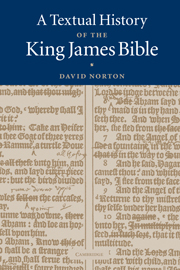Book contents
- Frontmatter
- Contents
- List of illustrations
- Acknowledgements
- List of abbreviations
- PART 1 THE HISTORY
- 1 Making the text
- 2 Pre-1611 evidence for the text
- 3 The first edition
- 4 The King's Printer at work, 1612 to 1617
- 5 Correcting and corrupting the text, 1629 to 1760
- 6 Setting the standard, 1762 and 1769
- 7 The current text
- PART 2 THE NEW CAMBRIDGE PARAGRAPH BIBLE
- PART 3 APPENDICES
- Bibliography
- General index
- Word index
- Index of biblical references
6 - Setting the standard, 1762 and 1769
from PART 1 - THE HISTORY
- Frontmatter
- Contents
- List of illustrations
- Acknowledgements
- List of abbreviations
- PART 1 THE HISTORY
- 1 Making the text
- 2 Pre-1611 evidence for the text
- 3 The first edition
- 4 The King's Printer at work, 1612 to 1617
- 5 Correcting and corrupting the text, 1629 to 1760
- 6 Setting the standard, 1762 and 1769
- 7 The current text
- PART 2 THE NEW CAMBRIDGE PARAGRAPH BIBLE
- PART 3 APPENDICES
- Bibliography
- General index
- Word index
- Index of biblical references
Summary
Three Bibles
Three outstanding folio Bibles were produced in the 1760s. The most famous was John Baskerville's (1763, H1146), ‘one of the finest books ever to have been printed in Britain’; McKitterick adds that ‘as such, it must take pride of place in the history of printing in Cambridge’ (II, p. 195). Yet, except in a negative way, it is an irrelevance as far as the history of the text is concerned. Baskerville had been appointed University Printer at Cambridge alongside, but not in co-operation with, the incumbent, Joseph Bentham. He was to undertake specific projects, including the folio Bible. His declared ambition was ‘to render this one Work as correct, elegant, and perfect as the Importance of it demands’; he would give his country ‘a more correct and beautiful Edition of the SACRED WRITINGS, than has hitherto appeared’. This is very much what Baskett's aim had been with his folio Bible, but this was no ‘Baskett-ful of errors’. Negatively, what is so striking is that ‘correct’, while promising freedom from typographical error, does not involve work on the text or the annotations. Baskerville's was a printer's, not a scholar's, Bible.
Though Baskerville could designate himself ‘Printer to the University’ on the title page, he was in competition with the Press's main commercial activity, as Bible printing now was — a major change since the beginning of the century. Cambridge's printing had been in a parlous state.
- Type
- Chapter
- Information
- A Textual History of the King James Bible , pp. 103 - 114Publisher: Cambridge University PressPrint publication year: 2005



